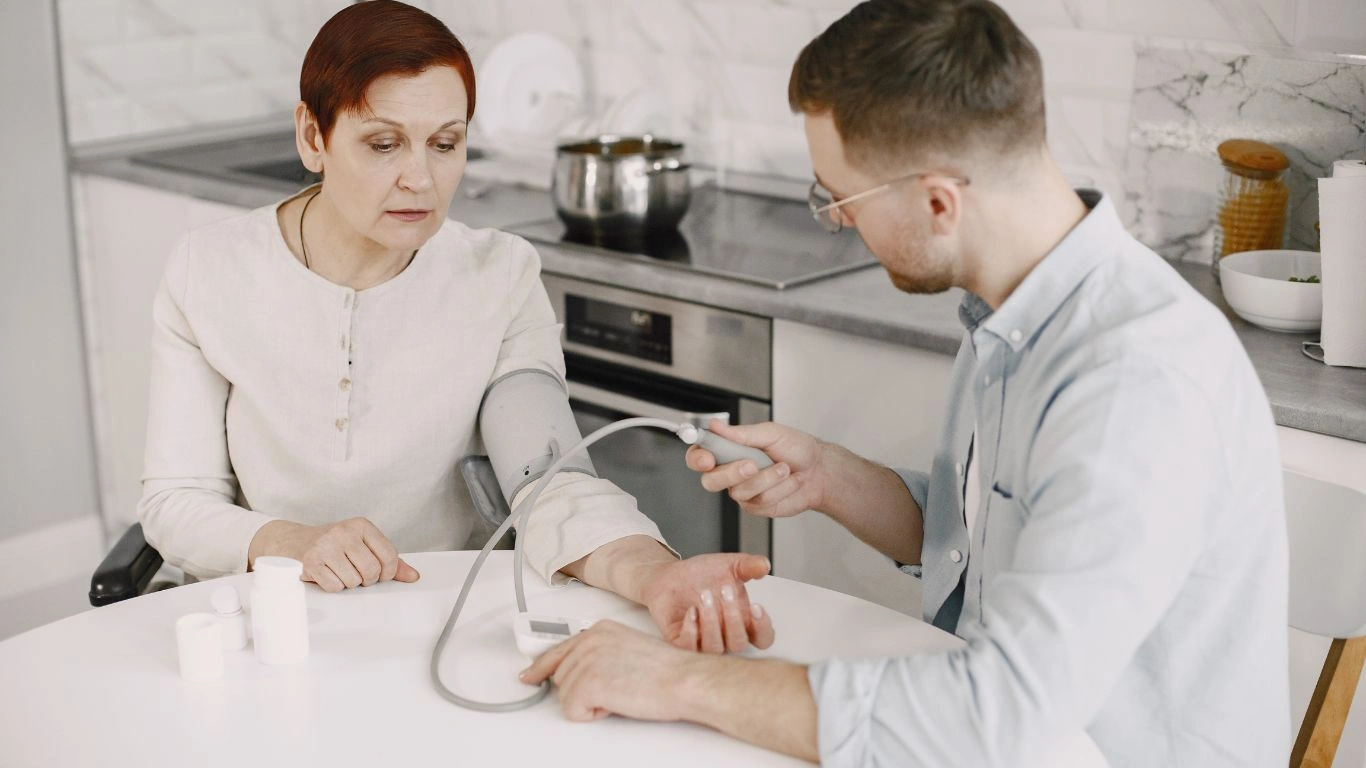Lower Blood Pressure at Work Fast: Simple Daily Habits That Work!
Balancing work responsibilities while keeping your blood pressure in check can feel like an impossible task. Trust me, as someone who has spent years studying hypertension and helping patients manage it, I know firsthand how stressful work environments can take a toll on your health. The good news? You don’t have to choose between your career and your well-being. With the right strategies, you can maintain healthy blood pressure at work without sacrificing productivity.
Understanding Work-Related Hypertension

Work stress isn’t just an annoyance—it’s a major contributor to high blood pressure. Long hours, tight deadlines, and constant meetings create the perfect storm for hypertension. But the real danger? Many people don’t even realize their job is negatively impacting their heart health until it’s too late.
Why Your Job Might Be Raising Your Blood Pressure
- Prolonged sitting: Sitting for extended periods reduces circulation and increases the risk of hypertension.
- Unhealthy eating habits: Rushed meals, fast food, and excessive caffeine can all spike blood pressure.
- Workplace stress: Chronic stress releases cortisol, which keeps blood pressure elevated.
- Sleep deprivation: Late-night work emails and early morning meetings can disrupt sleep, worsening hypertension.
How to Maintain Healthy Blood Pressure at Work

Now that we know what causes work-related hypertension, let’s dive into practical ways to manage it. These are the same strategies I recommend to my patients—and they work!
1. Move More, Sit Less
One of the simplest ways to combat high blood pressure at work is to avoid prolonged sitting. Try:
- Setting a timer to stand up and stretch every 30 minutes.
- Taking short walks during breaks—just five minutes can make a difference.
- Using a standing desk to switch between sitting and standing throughout the day.
2. Master Stress Management Techniques
Stress is inevitable, but how you handle it makes all the difference. Some easy techniques to try:
- Deep breathing exercises: Inhale for four seconds, hold for four, exhale for four.
- Mini meditation sessions: Even five minutes of mindfulness can lower blood pressure.
- Organizing your workload: Prioritizing tasks reduces the feeling of being overwhelmed.
3. Watch What You Eat & Drink
What you consume at work has a direct impact on your blood pressure. Consider:
- Swapping out processed snacks for nuts, fruits, or yogurt.
- Reducing caffeine intake—try herbal teas or decaf alternatives.
- Staying hydrated with water instead of sugary sodas.
Making Workplace Wellness a Priority

Maintaining healthy blood pressure at work isn’t just about making a few quick changes—it’s about creating a long-term plan that supports your overall well-being. Whether it’s adjusting your diet, reducing stress, or incorporating more movement into your day, every small step adds up. And trust me, your heart will thank you for it.
Optimizing Your Work Environment for Better Heart Health

Creating a heart-friendly workspace can make a huge difference in your overall health. I’ve seen patients thrive just by making a few simple changes in their office setup. Here’s what you can do:
1. Adjust Your Desk & Chair Setup
Believe it or not, poor posture can contribute to increased blood pressure. Consider:
- Keeping your monitor at eye level to reduce neck strain.
- Investing in an ergonomic chair to support your back and shoulders.
- Ensuring your feet are flat on the ground to promote circulation.
2. Use Natural Light & Greenery
Workspaces with natural light and indoor plants have been linked to reduced stress levels. If possible:
- Move your desk closer to a window for natural light exposure.
- Add a small plant to your desk—studies show greenery helps lower stress hormones.
3. Keep a Blood Pressure Monitor at Your Desk
Monitoring your blood pressure throughout the day can help you stay on top of your health. A quick check every few hours can alert you to any spikes and allow you to take action before things escalate.
How Coworkers & Employers Can Support a Heart-Healthy Workplace

You’re not in this alone! Encouraging a healthy work environment benefits everyone. Here’s how you and your colleagues can work together:
1. Advocate for Wellness Programs
If your workplace doesn’t already have wellness initiatives, consider suggesting:
- On-site yoga or stretching sessions.
- Healthy snack options in the breakroom.
- Company-sponsored gym memberships or fitness challenges.
2. Encourage Healthy Breaks
Instead of gossiping over donuts, encourage breaks that promote movement and relaxation:
- Take a short walk together during lunch.
- Do a few desk stretches as a team.
- Replace coffee breaks with a hydration challenge.
3. Communicate Openly About Health Concerns
High blood pressure can be a silent killer, but discussing it openly can lead to positive changes. Don’t be afraid to:
- Talk to HR about stress management initiatives.
- Encourage coworkers to check their blood pressure regularly.
- Share your own wellness journey—it might inspire others!
By making small, intentional changes in your work life, you can protect your heart and improve your overall well-being. Stay tuned for even more practical tips to keep your blood pressure in check—your future self will thank you!
Case Studies & Real-Life Examples

Sometimes, the best way to understand the impact of workplace habits on blood pressure is through real-life stories. Let me share a couple of cases that illustrate how small, consistent changes can make a big difference.
Case Study 1: The Stressed-Out Manager
Meet Mark, a 45-year-old project manager whose blood pressure had been creeping up for years. His doctor warned him that his stress-filled job was a major culprit. With long hours, tight deadlines, and back-to-back meetings, Mark rarely found time to move or relax.
After a major health scare, he made some simple but effective changes:
- He set hourly reminders to stretch and take short walks.
- He swapped out his three daily cups of coffee for herbal tea in the afternoon.
- He started using a standing desk for part of the day.
- He practiced deep breathing exercises before stressful meetings.
Within a few months, Mark’s blood pressure dropped, and he reported feeling more in control of his stress levels. His doctor was impressed, and so was he!
Case Study 2: The Sedentary Office Worker
Lisa, a 38-year-old accountant, spent most of her day sitting. She rarely drank water and often ate whatever was available in the breakroom (which, let’s be honest, was usually something unhealthy). After experiencing dizziness at work, she visited her doctor, who diagnosed her with early-stage hypertension.
Determined to turn things around, Lisa made a few changes:
- She started drinking a full glass of water every two hours.
- She packed healthy snacks like almonds and fruit to avoid vending machine temptations.
- She walked around the office for five minutes every hour.
- She incorporated meditation into her lunch break.
Six months later, Lisa’s blood pressure readings improved dramatically. She felt more energetic and even inspired some of her coworkers to adopt similar habits.
Key Takeaways: What You Need to Remember
If you’ve made it this far, you’re serious about keeping your blood pressure in check while at work. Here’s a quick recap of the most important takeaways:
- Move more, sit less: Break up long periods of sitting with standing, stretching, or short walks.
- Stay hydrated: Water is your best friend when it comes to maintaining circulation and reducing strain on your heart.
- Manage stress proactively: Deep breathing, meditation, and even simple breaks can make a big difference.
- Rethink your snacks: Opt for whole, nutrient-dense foods over processed, salty options.
- Monitor your progress: Keep an eye on your blood pressure readings and make adjustments as needed.
FAQs
Can my work environment really impact my blood pressure?
Absolutely! Prolonged stress, poor posture, excessive sitting, and even office snacks can contribute to high blood pressure. Small daily changes can significantly improve your numbers.
How often should I check my blood pressure at work?
If you have hypertension or are at risk, checking it once a week or whenever you feel unwell is a good idea. If you have a home monitor, tracking trends over time can help you make informed decisions.
Are there any quick stress relief techniques I can use at my desk?
Yes! Try deep breathing exercises, progressive muscle relaxation, or simply stepping outside for a breath of fresh air. Even a two-minute mental break can help lower your stress levels.
Bonus: Additional Resources or DIY Tips
For those who want to dive deeper into maintaining a healthy blood pressure at work, here are some great resources:
- American Heart Association – Learn more about hypertension management.
- CDC Blood Pressure Guidelines – Stay updated with the latest health recommendations.
- Mayo Clinic Healthy Lifestyle Tips – Practical advice for staying healthy at work and beyond.
If you prefer a DIY approach, here are a few easy things you can do today:
- Keep a reusable water bottle on your desk to encourage hydration.
- Use a reminder app to nudge you into movement every hour.
- Try a standing desk converter if you sit for long hours.
- Invest in a stress ball to help with tension release during meetings.
Appendix: Table, References, Disclaimer, and Call to Action
| Factor | Impact on Blood Pressure | Solution |
|---|---|---|
| Prolonged Sitting | Leads to poor circulation and higher BP | Take breaks and walk around regularly |
| High Stress | Triggers BP spikes | Practice breathing exercises and mindfulness |
| Poor Hydration | Can thicken blood and raise BP | Drink at least 8 glasses of water daily |
References:
Disclaimer: This article is for informational purposes only and is not a substitute for medical advice. Always consult your doctor before making changes to your lifestyle or health routine.
Call to Action: Now that you’ve got the tools to maintain healthy blood pressure at work, start implementing them today! Share your experiences in the comments, and if you found this article helpful, don’t forget to pass it along to your colleagues.

Dr. Gwenna Aazee is a board-certified Internal Medicine Physician with a special focus on hypertension management, chronic disease prevention, and patient education. With years of experience in both clinical practice and medical writing, she’s passionate about turning evidence-based medicine into accessible, actionable advice. Through her work at Healthusias.com, Dr. Aazee empowers readers to take charge of their health with confidence and clarity. Off the clock, she enjoys deep dives into nutrition research, long walks with her rescue pup, and simplifying medical jargon one article at a time.






